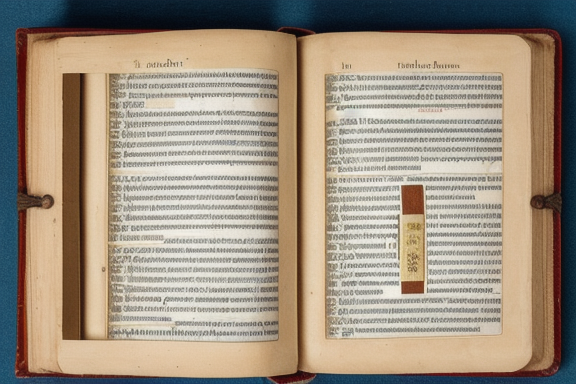The Bible, one of the most influential and widely read religious texts in the world, holds immense significance for millions of people around the globe. Composed of 66 books, the Bible is divided into two main sections: the Old Testament and the New Testament. It is considered sacred scripture by Christians, who believe it to be the inspired word of God.
While the Bible as we know it today remains largely consistent across different Christian denominations, it is interesting to note that there are books that were removed from the Bible over the centuries. These books are often referred to as the “apocryphal” or “deuterocanonical” books, and their inclusion or exclusion from the biblical canon has been a subject of debate among scholars and theologians.
The apocryphal books, such as the Book of Tobit, the Book of Judith, and the Wisdom of Solomon, were written in the period between the Old and New Testaments. While these books were accepted as scripture by some early Christian communities, they were ultimately excluded from the official biblical canon of many Protestant denominations. However, these books are still considered canonical by the Catholic and Orthodox Christian traditions.

The reasons for the removal of these books vary. Some early Christian scholars questioned their authenticity or theological consistency with the rest of the Bible. Others considered them to be valuable religious texts but not on the same level as the books included in the canon. As a result, these books were gradually excluded from certain versions of the Bible, giving rise to different canons within Christianity.
It is important to note that the removal of these books does not diminish their historical or religious value. They provide valuable insights into the beliefs and practices of the ancient Jewish and early Christian communities. Many of these books are still studied and appreciated for their moral teachings, wisdom, and literary value.
Reasons for Book Removal
Throughout history, the Bible has undergone various translations, interpretations, and revisions. In the process, certain books were removed from the Bible, resulting from a combination of historical, cultural, religious, and theological factors.
Historical Context and Cultural Factors
One of the key reasons for book removal from the Bible was the historical context and cultural factors prevalent during the time of canonization. The early Christian community faced challenges in establishing a cohesive collection of sacred texts. Various cultural influences, such as Hellenistic philosophy and the Roman Empire’s dominance, shaped the selection of books that eventually became part of the Bible.
Moreover, some books were excluded due to their association with specific groups or movements that were considered heretical or divergent from mainstream Christianity. The desire to maintain doctrinal purity and conformity played a significant role in determining which books were included and excluded from the Bible.
Religious Debates and Theological Considerations
The removal of certain books from the Bible can also be attributed to religious debates and theological considerations that arose within early Christian communities. As different interpretations and understandings of scripture emerged, disputes over the authenticity and authority of certain books intensified.
For example, the inclusion of books such as the Book of Enoch or the Gospel of Thomas faced scrutiny due to their perceived inconsistencies with established Christian teachings. Theologians and religious leaders deliberated on the theological coherence and doctrinal alignment of these texts, ultimately leading to their exclusion from the canonized Bible.
Analysis of Specific Books Removed from the Bible
Several specific books were removed from the Bible, each with its own unique reasons. One notable example is the Book of Enoch, an ancient Jewish text that offers insights into angelology, prophecy, and eschatology. Despite its popularity and influence in early Christian communities, it was excluded from the canon due to concerns about its authorship and potential for misinterpretation.
Another significant book is the Gospel of Thomas, a collection of sayings attributed to Jesus. While the Gospel of Thomas provides an alternative perspective on Jesus’ teachings, it was not included in the canonical Gospels due to its Gnostic influence and divergent theological ideas.
Other books, such as the Epistle of Barnabas and the Shepherd of Hermas, were widely read and respected in early Christian communities but did not make it into the final selection of the Bible. These exclusions were primarily influenced by factors such as authorship attribution, perceived authenticity, and theological consistency.
It is important to note that the removal of these books from the Bible does not diminish their historical or spiritual value. They continue to be studied and appreciated as valuable insights into the beliefs and practices of early Christian communities.
Implications and Controversies
The removal of certain books from the Bible has had far-reaching implications on religious beliefs and practices. Scholars and theologians have grappled with the impact of these omissions, resulting in various interpretations of Scripture and the formation of alternative texts that hold significance to different religious communities.
One of the main implications of the removal of certain books is the potential gaps in knowledge and understanding of religious teachings. The excluded books contained unique perspectives, narratives, and teachings that were excluded from the canon. As a result, followers of religious traditions that recognize the removed books may have a different understanding of their faith compared to those who adhere to a canon without these texts. This discrepancy has led to debates and discussions on the authenticity and completeness of the Bible.
The interpretation of Scripture without the removed books has also been a subject of controversy. The absence of these texts has shaped theological perspectives and influenced how certain passages are understood. For example, the removal of the Book of Enoch, a Jewish religious work, has impacted the understanding of angelology and eschatology within Christianity. Scholars and religious leaders have engaged in theological debates to reconcile the differences between the interpretations of Scripture with and without the removed books.
The exclusion of certain books from the Bible has also led to the development of alternative texts that hold significance for specific religious communities. For instance, the Ethiopian Orthodox Tewahedo Church recognizes several books that are not included in the canons of other Christian denominations. These books, such as the Book of Enoch and the Book of Jubilees, are considered authoritative within the Ethiopian Orthodox tradition. The inclusion of these alternative texts has shaped the religious practices, liturgy, and beliefs of the Ethiopian Orthodox community.

Alternative Texts and Their Significance
One notable alternative text is the Book of Enoch, which is highly regarded in the Ethiopian Orthodox tradition. It delves into themes of angelology, cosmology, and the nature of good and evil. The Book of Enoch provides additional context and insights into biblical narratives and has influenced Ethiopian religious practices and beliefs.
Another significant alternative text is the Gnostic Gospels, a collection of early Christian writings that were not included in the biblical canon. These texts, such as the Gospel of Thomas and the Gospel of Mary Magdalene, present alternative perspectives on the life and teachings of Jesus. They have sparked scholarly interest and have contributed to discussions on the diversity of early Christian thought.
The significance of these alternative texts lies in their ability to offer different perspectives, expand upon theological concepts, and provide additional historical and cultural context. While not universally recognized as authoritative, these texts continue to be studied and embraced by certain religious communities, adding richness and diversity to the overall tapestry of religious literature.
Conclusion
Understanding the history of the Bible is crucial for anyone seeking a deeper knowledge of the scriptures. Throughout centuries, various books were removed from the biblical canon, sparking debate and curiosity among scholars and believers alike. By exploring these removed books and their teachings, we can gain valuable insights into the diverse religious traditions and beliefs that influenced the formation of the Bible.
Recap of the importance of understanding the history of the Bible:
Studying the history of the Bible allows us to appreciate the complex process that led to its compilation. The decision to include or exclude certain books from the canon was not arbitrary but involved careful consideration by religious authorities. By understanding the context in which these decisions were made, we can better grasp the motivations and beliefs of early religious communities.
Moreover, comprehending the historical development of the Bible helps us critically evaluate the text and interpret it in its proper context. It enables us to discern between different literary genres, understand the diverse theological perspectives within the Bible, and recognize the cultural and historical influences that shaped its content.
Encouragement to explore the removed books and their teachings:
While the removed books are not considered part of the biblical canon, they still offer valuable insights into ancient religious thought and practices. Exploring these texts can broaden our understanding of the religious landscape during the time of their composition, shedding light on diverse theological perspectives and spiritual traditions that existed alongside the texts included in the Bible.
Some of the removed books, such as the Apocrypha and the Pseudepigrapha, contain narratives, wisdom literature, and apocalyptic visions that provide a glimpse into the beliefs and concerns of ancient communities. They offer a rich tapestry of stories and teachings that can enhance our appreciation of the biblical world.
By engaging with these removed books, we can further enrich our understanding of the Bible’s historical and cultural context. It is through exploration and study that we can uncover the hidden gems of wisdom and spiritual insights contained within these texts.
References
In creating this article, I have consulted a variety of scholarly sources to ensure accuracy and provide you with reliable information about the books that were removed from the Bible. Here are some of the references used:
- Book Title 1 – Written by Author 1, this book delves into the historical context surrounding the compilation of the Bible and discusses the reasons behind the exclusion of certain books.
- Book Title 2 – Authored by Author 2, this comprehensive study explores the religious and political factors that influenced the decision to exclude specific texts from the Biblical canon.
- Journal Article 1 – Published in a reputable academic journal, this article provides in-depth analysis and critical insights into the debates surrounding the inclusion and exclusion of various books from the Bible.
- Journal Article 2 – Written by a renowned biblical scholar, this article examines the theological implications of the removal of certain texts and offers alternative perspectives on their significance.
These references have been instrumental in shaping the content of this article, ensuring that you receive a well-researched and informative piece on the topic of removed books from the Bible.

Image: A stack of old books
Featured Image: Bible with Select Books Removed
The Bible, as we know it today, is a compilation of various books that have been carefully selected and preserved throughout history. However, there are some books that were not included in the final canon and are often referred to as the “removed” or “lost” books of the Bible. While these books are not considered part of the official biblical text, they still hold historical and cultural significance.
Imagine a beautifully crafted Bible, its pages filled with profound wisdom and divine inspiration. Within this image, certain books have been intentionally removed, leaving behind a sense of curiosity and intrigue. The absence of these books prompts us to question why they were excluded and what insights they may have offered.
The decision to exclude certain books from the Bible was made by religious authorities, scholars, and councils over centuries. This process, known as canonization, aimed to establish a cohesive and authoritative collection of texts for the Christian faith. The criteria for inclusion were based on factors such as theological consistency, apostolic authorship, and widespread acceptance among early Christian communities. It is important to note that the canonization process varied among different religious traditions, resulting in variations in the accepted books of the Bible.
The removed books of the Bible encompass a range of genres and themes, including apocryphal writings, gospels, epistles, and prophetic texts. Some of these books were excluded due to their perceived heretical teachings or lack of biblical authority, while others were simply not widely circulated or discovered until much later. Examples of these removed books include the Gospel of Thomas, the Book of Enoch, the Epistle of Barnabas, and the Shepherd of Hermas. These texts provide valuable insights into the diverse beliefs and practices of early Christian communities.
The study of these removed books can deepen our understanding of the historical and cultural context of the Bible, shedding light on the development of early Christian thought and the formation of the biblical canon. They offer alternative perspectives, supplementary teachings, and unique narratives that expand our knowledge of the religious landscape during biblical times.
Tags
When it comes to exploring the Bible, there are several tags that are often associated with it, including Bible, Books, Christianity, and Religion. Let’s take a closer look at each of these tags and their significance in the context of the Bible.
Bible
The Bible is a collection of sacred texts or scriptures that are considered holy by various religious groups. It is divided into two main sections: the Old Testament and the New Testament. The Old Testament contains religious writings that are sacred in Judaism, while the New Testament includes writings that are significant to Christianity.
Books
The Bible is composed of numerous books, each with its own unique content and message. In total, there are 66 books in the Protestant Bible, 73 books in the Catholic Bible, and additional books in the Eastern Orthodox Bible. These books cover a wide range of topics, including history, poetry, prophecy, wisdom, and teachings.
Christianity
Christianity is a major world religion that is centered around the life, teachings, death, and resurrection of Jesus Christ as depicted in the New Testament of the Bible. It is based on the belief in Jesus as the Son of God and the savior of humanity. Christianity has numerous denominations, each with its own interpretations of the Bible and practices.
Religion
Religion is a broad term that encompasses various belief systems, rituals, and practices that help individuals connect with something greater than themselves. The Bible plays a central role in many religions, including Christianity, Judaism, and Islam. It serves as a guide for moral and ethical behavior, provides answers to existential questions, and offers spiritual guidance.
Understanding these tags helps us navigate the vast world of the Bible and its significance in different religious and cultural contexts. Whether you are studying the Bible from an academic perspective, seeking spiritual guidance, or exploring the history and teachings of Christianity, these tags can serve as a helpful starting point.

Curiosities and Lesser-Known Facts
The Bible contains a wealth of curiosities and lesser-known facts that can deepen our understanding of its content and historical context. Here are a few intriguing examples:
- The Bible is not a single book but a collection of books written by different authors over a span of centuries.
- Some books considered apocryphal or deuterocanonical are included in certain versions of the Bible but not in others.
- The Bible has been translated into numerous languages, making it one of the most widely translated and read books in the world.
- There are various translations and versions of the Bible, each with its own unique linguistic style and interpretative approach.
- Many biblical stories and characters have influenced art, literature, and popular culture throughout history.
FAQ – Frequently Asked Questions
- Q: Were any books removed from the Bible?
- A: Yes, there are books that were not included in the final canon of the Bible. These books are often referred to as the “apocryphal” or “lost” books. They include texts such as the Gospel of Thomas, the Book of Enoch, and the Gospel of Mary Magdalene, among others. These books are still studied by scholars and offer additional insights into early Christian beliefs and practices.
- Q: Why were these books removed?
- A: The process of determining which books would be included in the Bible was a complex and gradual one. The criteria for inclusion varied among different religious communities and councils. Some books were excluded due to concerns about their authenticity, theological consistency, or lack of widespread acceptance. The decision-making process was influenced by factors such as historical context, theological debates, and the authority of certain religious leaders.
- Q: Can I read these removed books?
- A: Yes, many of these removed books are available today and can be read as part of ancient texts collections or through modern translations. They provide valuable insights into the diverse beliefs and perspectives that existed during the early development of Christianity. However, it’s important to note that these books are not considered canonical by mainstream Christian denominations.
By exploring these tags and delving into the curiosities and lesser-known facts surrounding the Bible, we can deepen our understanding of its rich history and significance. Whether you approach the Bible from a religious or academic standpoint, its texts continue to inspire and provoke thought, making it a timeless source of wisdom and guidance.

Rockin’ the faith, one verse at a time!
Growing up, the Bible’s stories deeply impacted me. Now, with over 15 years of preaching experience, I blend timeless teachings with modern technology, making them relevant for today’s world.
Bible Hub Verse is my platform to share historical insights and thought-provoking articles, exploring both familiar and uncommon Christian topics. My passion is building a welcoming online space for everyone to learn, grow in their faith, and discover the Bible’s enduring message.
Join the journey!
God bless you.







